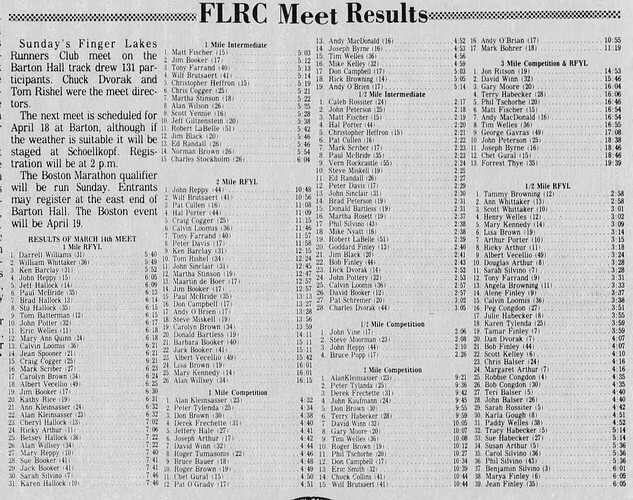Bit of a story here. About a year ago, I heard from Don Campbell, a former FLRC runner who ran across some archived race results from the Ithaca Journal from 1975 or 1976 (back when the local newspaper would print race results!). Don was curious what the RFYL acronym was for, and while I assumed it was “Run For Your Life,” I cc’d some folks who might know more.
Former local Caleb “Spider” Rossiter, who’s a regular at Hartshorne, replied:
Ha! I think your guess about RFYL is a good one, but who knows? I await instruction…Spiderlike
p.s. the Booker family and the Kleinsasser and Reppy married couples were regulars for years. Jim ran in some Triennials for and against Atrocious. George Gavras I think appeared in some early Hartshorne miles, and Chuck Collins was Don Farley’s constant competitor down thru the years. Check out Sarah Rossiter, at age 5, and her 4:42 half mile – she’s, yep, 52 now!
His brother, David “Truck” Rossiter (@D_G_Rossiter), chimed in too, saying:
I seem to remember that RFYL = Run For Your Life was for runners not affiliated with the AAU. I remember that when I ran my first Ithaca 10 in 1978 I had to join the AAU. The local rep. was someone up on Bryant Ave. or nearby. So maybe this was the division between « competitive » (AAU) and non- (RFYL). Or else it was part of a programme based on the Cooper test (distance in 12 minutes) and these were participants. I know Jim Hartshorne tried this to get more people to start running.
Among the other names notice Eric Smith who later became big in CNY Orienteering, including organizing ROGAINES in the region.
That gave me enough to go on to find more about the RFYL program at the RRCA and from Gabe Mirkin:
And then past FLRC president and current track starter Tom Rishel (@Rishel) provided more local color:
Yes, “RFYL” definitely was the acronym for “Run for Your Life,” and the idea originated with the Road Runners’ Club of America (RRCA), which had just begun to come to prominence as an alternative to the AAU, whose successor is nowaday’s TAC.
The meet results that Adam has posted are from March, 1975, I think [maybe 1976 – my age is listed as 34 years… but don’t trust that, 'cuz I note one competitor listed in two different races with two different ages]. Jim Hartshorne was still the FLRC club president, and he probably listed Chuck Dvorak and me as “race directors” because I held the clipboard while Chuck called off finisher times at the end of the races. Note how Jim separated each individual race as Competition, Intermediate and RFYL.
The Ithaca Journal article was probably written up by either Terry Habecker or Bob Congdon to be placed in the paper. Note how the article itself ends with the terse announcement of the upcoming “Boston Qualifier marathon,” the race that I later replaced with the Skunk Cabbage in, when, 1984?
Lots of names I remember, like Wilf Brutseart, Terry H., John Kaufmann, Paul McBride (faculty at I.C.), Jim and Sue Booker and their mom and dad; Cal Loomis, George Gavras (postman in Groton) etc.
I’d been meaning to share the conversation here for some time but hadn’t gotten around to it. And then I got another email from Ken Barbee from Drexel, who also raced at Hartshorne recently. He had inherited a treasure trove of running-related publications from his self-avowed track nut father, and while flipping through issues of Distance Running News, the precursor to Runner’s World, he ran across and forwarded an article by Jim Hartshorne, the founder of FLRC, entitled “Over-40 Running and the Masters Mile.” It’s a fascinating look at the early days of masters athletics from one of the guys who did more to make it happen than nearly anyone. There’s even a photo of Jim in an FLRC jersey winning the mile at the Heptagonal Games in 4:46… taken by his son Tom Hartshorne (@tom-hartshorne)!
Hartshorne Article.pdf (651.3 KB)
To tie these two events together, Jim Hartshorne’s article mentions Gabe Mirkin as one of the creators of the Run For Your Life program in 1964. Mirkin was a sports medicine doctor who also coined the term RICE (Rest Ice Compression Elevation), but who has since changed his advice because ice delays recovery.
Although he’s retired from practice now, he still publishes a free bi-weekly health email newsletter that rounds up the latest evidence-based recommendations on a variety of health topics, including those associated with exercise. I find it extremely informative—worth subscribing if you’re interested.
We now return you to 2024.
